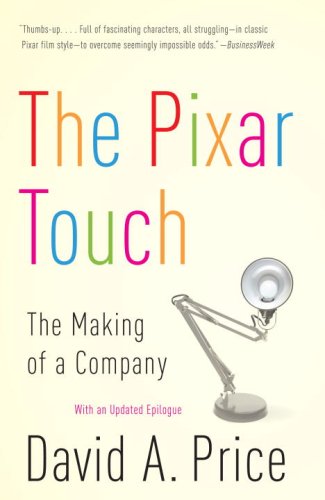Review: The Pixar Touch: The Making of a Company, by David A. Price
I hate biographies. Histories, I can do. But biographies lack a certain personality, as if they're hiding something. Histories are different because any American can write a history of America, but no one can write a biography of Laurence Olivier and claim to be Laurence Olivian. So I was happy when I realized that my long-anticipated read, The Pixar Touch was treated like a happy mix of the two mediums.
David Price has certainly done his research and Pixar's story flows beautifully on the page. I knew the basics already. I knew that Pixar had started in a garage like so many of its computing contemporaries, that Steve Jobs had acquired the company in the 80s, and that Disney had acquired the company in the past few years. I was already familiar with all of their feature films (the only one I haven't seen is Cars) and about half of their animated shorts. But the story is so much richer than the bare factual bones. The desire to make better animation goes so much deeper than the first 3-D-like effects achieved in the first Toy Story.
I didn't know anything about the core of the company. I didn't know the trials that the artists had suffered before and after their initial success. And I certainly lacked an appreciation for computer animation. Before reading this book, I liked a lot of what Pixar had to offer but I still felt like even that was a betrayal of my love for hand-drawn 2-D animation. Oh I was so wrong. Price managed to take me on a journey so rife with emotion that I actually cried while reading it on the train when I got to the part where Toy Story was first released.
At the root of my being wrong was my dreaded enemy*, Michael Eisner. Because of his actions, the upward spiral of 3-D animation went hand-in-hand with the closure of Disney's 2-D animation studios. It was him, all along. Not computer animation. This is not to say that I don't still have my reservations** about computerized animation and its potential, but my appreciation for the process has increased tenfold.
I only wish that the book was updated to now. Since the book was published in 2008, Pixar has released two films (Wall-E and Up). Wall-E is, by far my favorite Pixar film and Up is arguably the best*** of theirs according to most people I talk to. If the book were updated to this point, I would feel complete in my knowledge. I would love to be as aware of the process for Wall-E as I am for Toy Story and Monsters, Inc. Perhaps I'll just have to wait for Ed Catmull and John Lasseter to write their autobiographies. I might even read 'em.
* Michael Eisner has been my dreaded enemy for nearly 15 years.
** Dreamworks can suck it
*** I disagree
David Price has certainly done his research and Pixar's story flows beautifully on the page. I knew the basics already. I knew that Pixar had started in a garage like so many of its computing contemporaries, that Steve Jobs had acquired the company in the 80s, and that Disney had acquired the company in the past few years. I was already familiar with all of their feature films (the only one I haven't seen is Cars) and about half of their animated shorts. But the story is so much richer than the bare factual bones. The desire to make better animation goes so much deeper than the first 3-D-like effects achieved in the first Toy Story.
I didn't know anything about the core of the company. I didn't know the trials that the artists had suffered before and after their initial success. And I certainly lacked an appreciation for computer animation. Before reading this book, I liked a lot of what Pixar had to offer but I still felt like even that was a betrayal of my love for hand-drawn 2-D animation. Oh I was so wrong. Price managed to take me on a journey so rife with emotion that I actually cried while reading it on the train when I got to the part where Toy Story was first released.
At the root of my being wrong was my dreaded enemy*, Michael Eisner. Because of his actions, the upward spiral of 3-D animation went hand-in-hand with the closure of Disney's 2-D animation studios. It was him, all along. Not computer animation. This is not to say that I don't still have my reservations** about computerized animation and its potential, but my appreciation for the process has increased tenfold.
I only wish that the book was updated to now. Since the book was published in 2008, Pixar has released two films (Wall-E and Up). Wall-E is, by far my favorite Pixar film and Up is arguably the best*** of theirs according to most people I talk to. If the book were updated to this point, I would feel complete in my knowledge. I would love to be as aware of the process for Wall-E as I am for Toy Story and Monsters, Inc. Perhaps I'll just have to wait for Ed Catmull and John Lasseter to write their autobiographies. I might even read 'em.
* Michael Eisner has been my dreaded enemy for nearly 15 years.
** Dreamworks can suck it
*** I disagree

Comments
Post a Comment
Any and all feedback is welcome - thanks for taking the time!